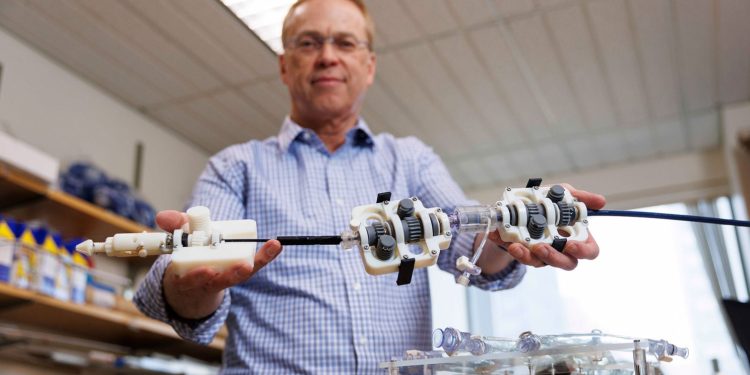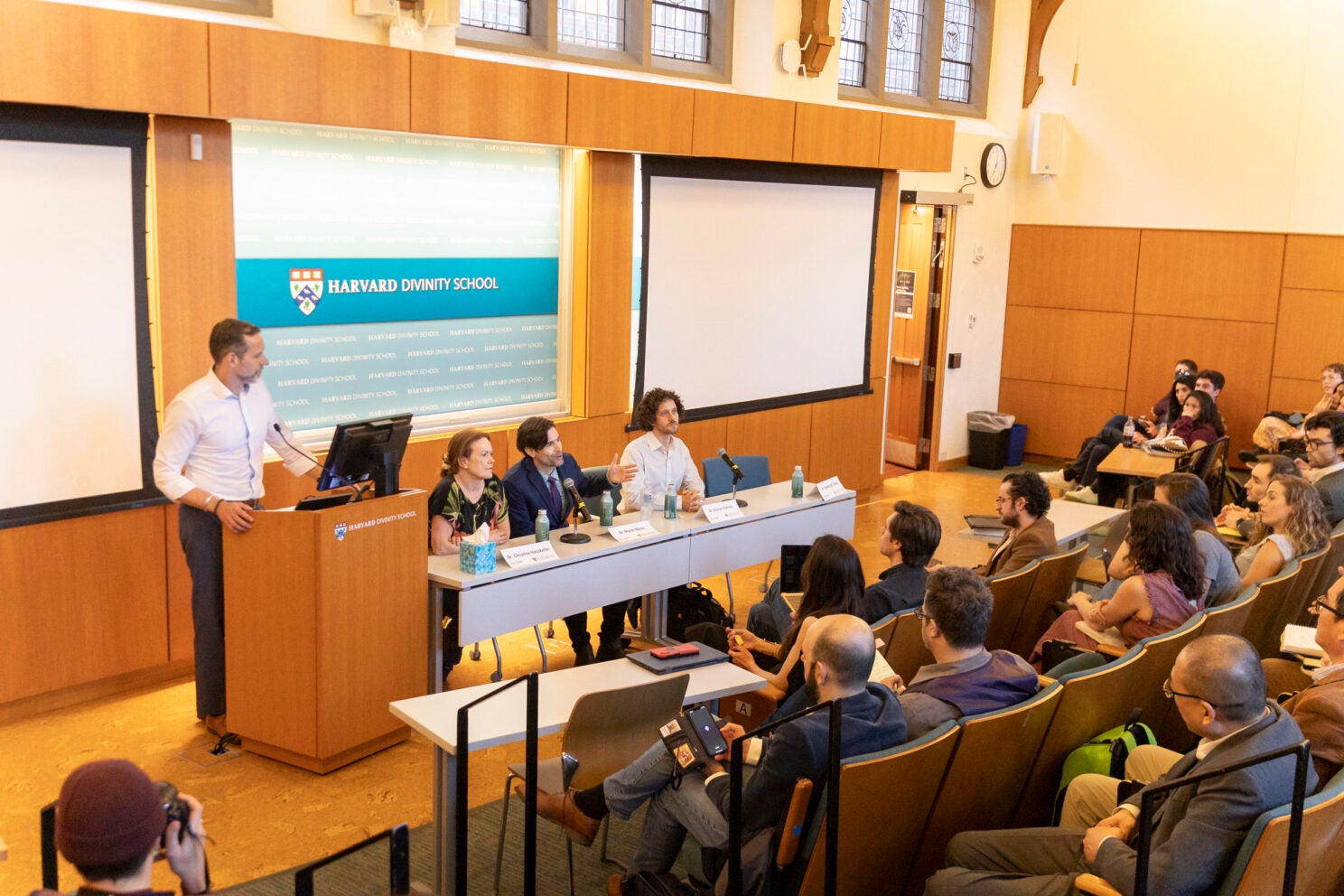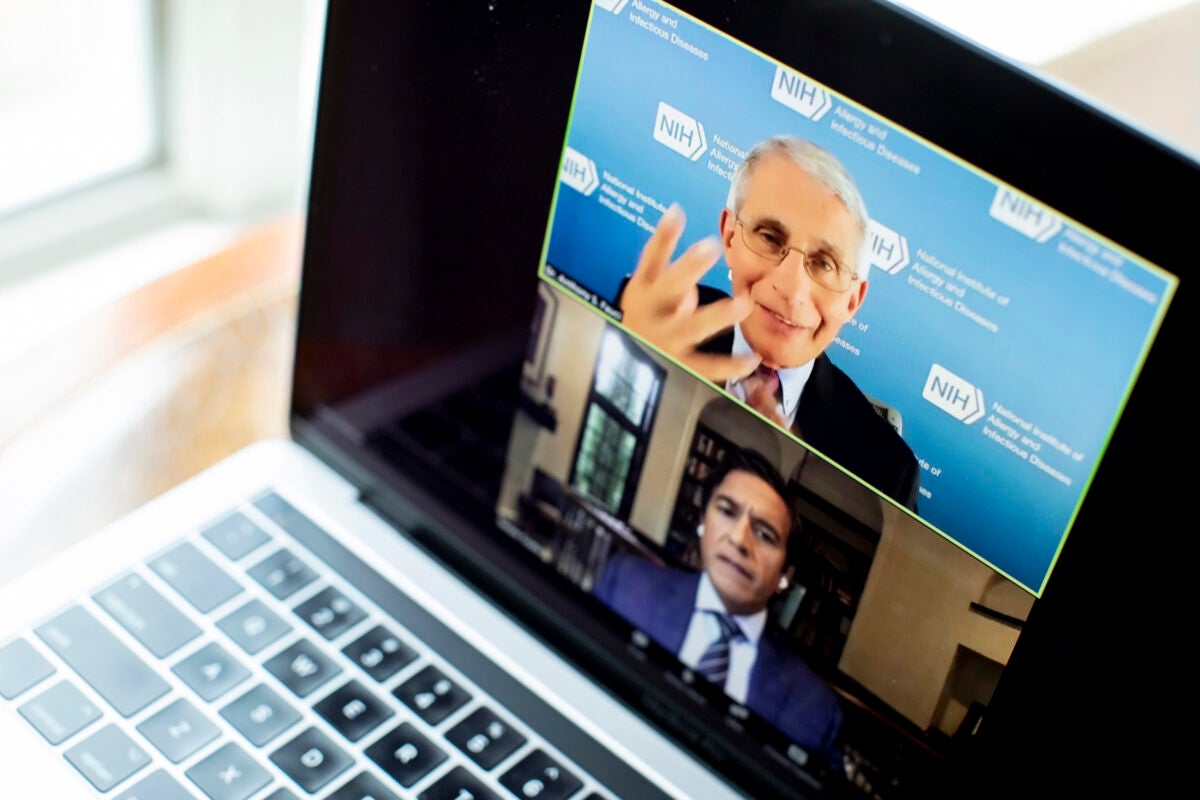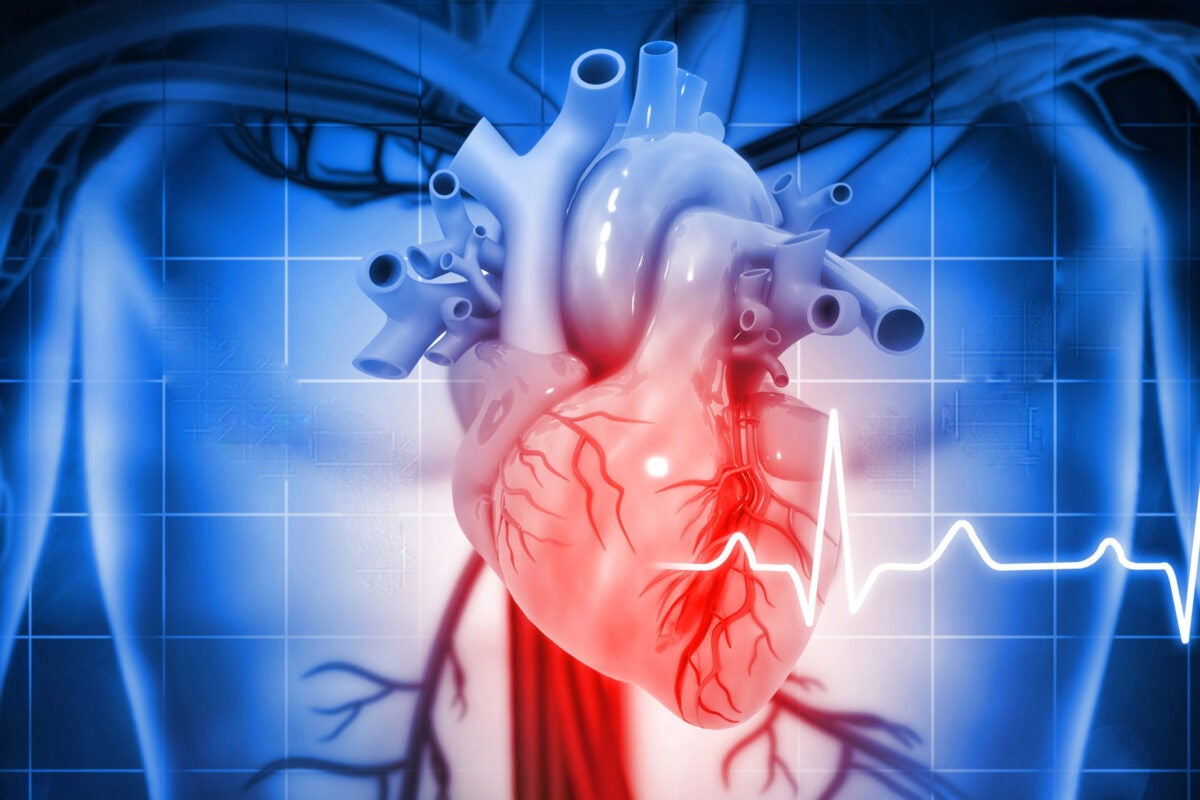Health
Dr. Robot will see you now?
Pierre E. Dupont holds a transcatheter valve repair device with a motorized catheter drive system, replacing the traditional manual handle.
Niles Singer/Harvard Staff Photographer
Medical robotics expert says coming autonomous devices will augment skills of clinicians (not replace them), extend reach of cutting-edge procedures
The robot doctor will see you now? Not for the foreseeable future, anyway.
Medical robots today are pretty dumb, typically acting as extensions of a surgeon’s hands rather than taking over for them. Pierre E. Dupont, professor of surgery at Harvard Medical School, co-authored a Viewpoint article in the journal Science Robotics last month saying that autonomous surgical robots that learn as they go are on the way.
But their likely impact will be to augment the skills of clinicians, not replace them, and to extend the reach of cutting-edge advances beyond the urban campuses of academic medical centers where they typically emerge.
In this edited conversation, Dupont, who is also chief of pediatric cardiac bioengineering at Boston Children’s Hospital, spoke with the Gazette about the areas most likely to see surgical robots operating autonomously, and some of the hurdles to their adoption.
You note that robot autonomy and learning system technologies are being used in manufacturing as well as medical settings. How does that work?
Yes, in just about every other field, robots are used as autonomous agents to replace the manpower that would be needed to perform a task. But in many surgical applications, like laparoscopy, they’re used as extensions of the clinician’s hand. They improve ergonomics for the clinician, but there’s still some question as to how much they’re improving the experience for the patient.
Outside of medicine, teleoperation, in which the operator uses a mechanical input device to directly control robot motion, is only used in remote or hostile environments like space or the ocean floor. But it’s how laparoscopic robots are controlled.
The hot extension today, which ties into hospital economics, is telesurgery, where you might have a Boston-based hospital and satellite facilities in the suburbs. Rather than the clinician being with the patient in the operating room, you would have robots at the satellite hospitals, and the clinician could stay at the main hospital and connect remotely to perform procedures. That’s trending today, but it’s not automation.
What would an automated procedure look like?
Some simpler medical procedures are already automated using non-learning methods.
In joint replacement, for example, you need to create a cavity in the bone to place an implant. Historically, the skill of the clinician determined how well the implant fit and whether the joint alignment was appropriate.
But there’s a strong parallel with machining processes, which was the impetus for creating robots to mill cavities in the bone — leading to more accurate and consistent outcomes. That’s a big market today in orthopedics.
The autonomy of the milling robot is possible because it’s a well-defined problem and easy to model. You create a 3D model of the bones and a clinician can sit at a computer interface and use software to define exactly how the implant will be aligned and how much bone will be removed. So everything can be modeled and preplanned — the robot is basically just following the plan. It’s a dumb form of automation.
“Rather than the clinician being with the patient in the operating room, you would have robots at the satellite hospitals, and the clinician could stay at the main hospital and connect remotely to perform procedures. ”
Pierre E. Dupont
That’s because of the nature of the bone and the implant. The dimensions are known. Nothing’s moving like it would if you were operating on a beating heart.
That’s right, although I think transcatheter cardiac procedures and endovascular procedures in general are actually great targets for automation.
The geometry is not as well-defined as orthopedic surgery, but it’s much simpler than in laparoscopy or any type of open surgery where you’re dealing with soft tissue.
In soft tissue surgery, you’re using forceps, scalpel, and suture to grasp, cut, and sew tissue. The clinician, through experience, has a model in their head of how hard they can squeeze the tissue without damaging it, how the tissue will deform when they pull on it and cut it, and how deeply they have to place the needle while suturing.
Those things are much harder to model with classical engineering techniques than milling bone.
How much of the progress in this area is due to the speed of technological development versus acceptance among clinicians and patients?
If you just think about robotics, the amount of acceptance is surprising. A lot of academic clinicians love to play with new toys. Many patients, perhaps incorrectly, assume that the clinician must do a better job with this incredible piece of equipment.
Hospitals want to know about costs. They don’t necessarily care if the clinician’s back is a little less sore at the end of the day because they used a robot. They want to know whether the patient had fewer complications and was discharged sooner — in other words, better care for less money. That’s the tough aspect of this: Robots cost more to make and roll out than most other medical equipment.
When you talk about the acceptance of medical robot automation, clinicians may be a little reluctant because they wonder whether they are going to lose their jobs. But it’s actually like giving them a highly effective tool that can raise their skill level.
There are a lot of clinicians who may only see a particular procedure 10 times a year. If you think of anything that’s complex in life that you only do once a month, you’re not going to do that as well and feel as confident as if you did it every day.
So, if the robot is not replacing them, but acting like a highly experienced colleague whom you can communicate with, and who can coach you through the procedure, explaining, “Now I’m going to do this.” Or ask, “Do you think I should do it this way?” or “Should I put this device a little to the left?” I think there’ll be acceptance. If you have a system that can bend a clinician’s learning curve down and raise their proficiency level very quickly, every clinician will want one.
How important are recent advances in large language models and other forms of AI in the discussion of autonomy?
These advances are what is going to enable progress in medical robot autonomy. We’re working on transcatheter valve repair procedures that right now are done by hand. Clinicians need to do a lot of these procedures to get good at them — and to stay that way.
We have seen in my lab that adding a robotic teleoperation makes them easier. But if we can add learning-based autonomous functionality, we could make it possible for these procedures to be safely offered in low-volume facilities.
That’s important because a significant concern is that you get the best care and the newest treatments in the big urban areas that have academic medical centers. But many people don’t live in those areas and even though they could travel to get treatment, they want to get treated locally.
So, if you can enable community hospitals to offer these services, even though they’re low-volume, that’s an opportunity for a much larger fraction of the population to take advantage of the best medical care.
When we look further out, do you have any doubt that medicine will become more autonomous?
I think there’s a lot of opportunity for increasing levels of autonomy, but it has to be done gradually. You want to make sure that you’re regulating it so that patients are always safe.
There will be unanticipated events, such as unusual anatomical variations, that the system hasn’t been trained for. You need to make sure that the system will catch these problems as they come up — it needs to recognize when it’s out of its depth.
Currently, that’s a research topic in learning systems — there is technology that still needs to be developed. But the revolution over the last few years in foundation models has shown us how much is possible.
Ultimately, will there be a case where there’s no clinician involved? We don’t have to worry about that question yet.
You mentioned that these systems are expensive. Will costs come down the more they’re used?
The challenge is that medical devices are designed and approved for specific procedures. If you want to create a new medical device, you need to look at how many procedures are performed per year, and what the reimbursements are for those procedures.
For any medical device — not a robot — the smallest realistic market size is $100 million in sales per year. And if you want to raise venture capital funding, the market has to be at least a billion dollars.
Since medical robots are so expensive to develop, that means you should have a multibillion-dollar market for a medical robot. Those markets do exist: Laparoscopy and orthopedics are current examples. Endovascular procedures including heart valve repair and replacement are another that I am targeting.
An important factor for each of these three examples is that the robot is a platform. It can be used for a variety of procedures and so has a much larger addressable market than a robot that can only do one thing.














